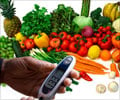Highlights:
- A rapid and non-invasive screening test based on skin autofluorescence has been developed for the first time
- This new test can predict a person’s future risk of type 2 diabetes and heart disease
- Skin autofluorescence test can be used in non-medical settings such as at supermarkets or drug stores to know if your at risk of diabetes and heart disease.
Read More..
What is Skin Autofluorescence (SAF) in Diabetes?
Type 2 diabetes is showing an alarming rise globally and cardiac complications occurring in diabetes are a major cause for reduced quality of life and premature death in these patients. Risk factors known to increase the occurrence of type 2 diabetes include obesity and high fasting blood glucose levels.Fluorescence is a phenomenon that occurs when a substance/chemical absorbs light or other electromagnetic radiation and gives out a light of a different wavelength. It typically occurs when the absorbed radiation is in the ultraviolet region of the spectrum, (invisible to the human eye), while the light emitted is in the visible region, which gives the fluorescing chemical a distinct color.
Persons with high blood glucose levels have increased levels of chemicals called advanced glycation end products in their skin. The research team obtained the readings when the chemical fluoresce (skin autofluorescence) was illuminated with a light source.
The current study hoped to determine whether skin autofluorescence readings can predict future risk of type 2 diabetes, heart disease and premature death in the general population
Can Skin Autofluorescence Predict Type 2 Diabetes Heart Disease Risk ?
The prospective study included 72880 participants of the Dutch Lifelines Cohort Study, who had baseline investigations performed between 2007 and 2013. They had validated baseline skin autofluorescence values available, and were not found to have type 2 diabetes or heart disease at during this period- During follow-up, patients were diagnosed as diabetic either by self-report or fasting blood sugar values of 7.0 mmol/l or HbA1c 48 mmol/mol (6.5%)
- Similarly participants were diagnosed as having heart disease by self report which included a heart attack (myocardial infarction), coronary interventions, stroke, transient ischaemic attack, lower limb pain on walking short distances (intermittent claudication) or vascular surgery
- Death was confirmed by the Dutch Municipal Personal Records Database
- On completion of the follow-up period ranging from 0.5 to 10 years (average 4 years), 1056 (1.4%) developed diabetes, 1258 (1.7%) developed heart disease and 928 (1.3%) had died
- Baseline skin autofluorescence (SAF) was higher in participants who developed type 2 diabetes and/or CVD and in those who had died compared to persons who survived and remained free of either disease
- A single unit higher value of skin autofluorescence was associated with a three-fold increase in the risk of type 2 diabetes or CVD, and a five times increased the risk of death
- Skin autofluorescence readings were able to predict the development of type 2 diabetes and heart disease independent of several known risk factors, such as metabolic syndrome, obesity, HbA1c and high blood glucose.
- After due adjustment for other risk factors, a 1 point higher value of skin autofluorescence (SAF) showed 26%, 33% and 96% increased the risk for type 2 diabetes, heart disease and premature death, respectively
What are Advanced Glycosylation End (AGE) Products?
Advanced glycation end products (AGEs) are toxic chemicals formed when protein or fat in the body tissues combine with sugar in the bloodstream. Persons with high blood sugar levels, such as diabetics, are at increased risk of forming large amounts of AGEs, which can accumulate in various tissues of the body.Conclusion
It may soon be possible to know if your at risk of developing diabetes or heart disease in a supermarket or drug store by means of a rapid and non-invasive screening test so that suitable measures can be taken to reduce the risk and avoid future complications.In the words of the study authors, "Our study supports the clinical utility of SAF as a first screening method to predict type 2 diabetes, CVD and mortality. Other risk indicators, such as the presence of the metabolic syndrome, require more extensive measurements. The quick, non-invasive measurement of skin autofluorescence may even allow use in non-medical settings or public locations such as supermarkets, pharmacies or drug stores as a first estimate of risk."
References:
- Study shows skin autofluorescence can predict type 2 diabetes, cardiovascular disease and death - (https://diabetologia-journal.org/2018/11/21/study-shows-skin-autofluorescence-can-predict-type-2-diabetes-cardiovascular-disease-and-death/)
Source-Medindia
















